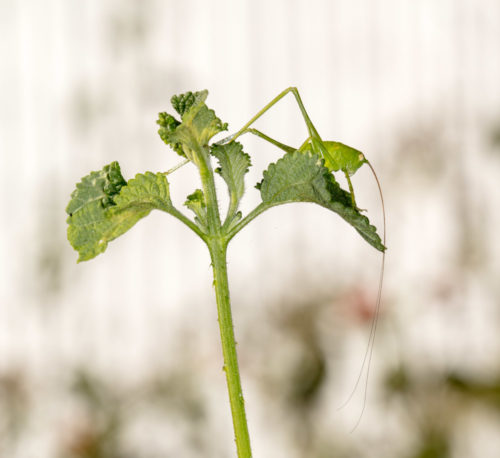
I found this katydid perched on a leaf of Chromolaena odorata in my garden. I used Canon EOS 5DS R with Canon EF 100mm f/2.8L Macro IS USM lens. This was illuminated by Godox Ving V860c E-TTL Li-ion Camera with LumiQuest SoftBox III.

Insects in the family Tettigoniidae are commonly called katydids or bush crickets. More than 6,400 species are known. Part of the suborder Ensifera, Tettigoniidae is the only family in the superfamily Tettigonioidea. Primarily nocturnal in habit, with strident mating calls, many katydids exhibit mimicry and camouflage, commonly with shapes and colours similar to leaves.

Tettigoniids range in size from as small as 5 to as large as 130 mm. The smaller species typically live in drier or more stressful habitats which may lead to their small size. The small size is associated with greater agility, faster development, and lower nutritional needs. Tettigoniids are free-living insects that are most commonly heard at night during summer and early fall. Tettigoniids may be distinguished from the grasshopper by the length of their filamentous antennae, which may exceed their own body length, while grasshoppers’ antennae are always relatively short and thickened.
The lifespan of a katydid is about a year, with full adulthood usually developing very late. Females most typically lay their eggs at the end of summer beneath the soil or in plant stem holes. The eggs are typically oval-shaped and laid in rows on the host plant. The way their ovipositor is formed relates to its functional adaptability in the areas which it lays eggs. The ovipositor is an organ used by insects for laying eggs. It consists of a maximum of three pairs of appendages formed to transmit the egg, to prepare a place for it, and place it properly.

Tettigoniids have either sickle-shaped ovipositors which typically lay eggs in dead or living plant matter or uniform elongated ovipositors which lay eggs in grass stems. When tettigoniids hatch, the nymphs often look like smaller versions of the adults, but in some species, the nymphs look nothing at all like the adult and rather mimic other species such as spiders and assassin bugs, or flowers, to prevent predation. The nymphs remain in a mimic state only until they are large enough to escape predation. Once they complete their last moult, they are then prepared to mate.
Tettigoniids are found on every continent except Antarctica. The diet of tettigoniids includes leaves, flowers, bark, and seeds, but many species are exclusively predatory, feeding on other insects, snails, or even small vertebrates such as snakes and lizards. Some are also considered pests by commercial crop growers and are sprayed to limit growth, but population densities are usually low, so a large economic impact is rare. By observing the head and mouthparts, where differences can be seen in relation to function, it is possible to determine what type of food the tettigoniids consume. Large tettigoniids can inflict a painful bite or pinch if handled, but seldom break the skin.

The males of tettigoniids have sound-producing organs (via stridulation) located on the hind angles of their front wings. In some species, females are also capable of stridulation. Females chirp in response to the shrill of the males, which sound like, “katy did,” which is how they received their name. The males use this sound for courtship, which occurs late in the summer. The sound is produced by rubbing two parts of their bodies together, called stridulation. One is the file or comb that has tough ridges; the other is the plectrum is used to produce the vibration. For tettigoniids, the fore wings are used to sing. Tettigoniids produce continuous songs known as trills. The size of the insect, the spacing of the ridges, and the width of the scraper all influence what sound is made.

